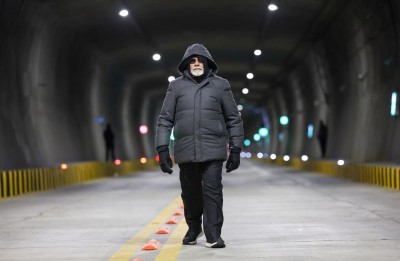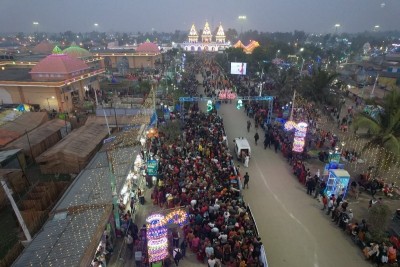 Sun Mission
Sun Mission
Sun Mission: Aditya-L1's ASPEX instrument begins measurements
Chennai/UNI: The Aditya Solar wind Particle Experiment (ASPEX) payload onboard India's first sun exploratory mission Aditya-L1 satellite has commenced its operations and is performing normally.
ISRO in an update on Saturday said ASPEX comprises two cutting-edge instruments – the Solar wind Ion Spectrometer (SWIS) and STEPS (SupraThermal and Energetic Particle Spectrometer).
The STEPS instrument was operational on September 10, 2023. The SWIS instrument was activated on November 2, 2023, and has exhibited optimal performance.
SWIS, utilizing two sensor units with a remarkable 360° field of view each, operates in planes perpendicular to one another. The instrument has successfully measured solar wind ions, primarily protons and alpha particles.
A sample energy histogram acquired from one of the sensors over two days in November 2023 illustrates variations in proton (H+) and alpha particle (doubly ionized helium, He2+) counts. These variations were recorded with nominal integration time, providing a comprehensive snapshot of solar wind behaviour.
The directional capabilities of SWIS enable precise measurements of solar wind protons and alphas, contributing significantly to addressing longstanding questions about solar wind properties, underlying processes, and their impact on Earth.
The change in the proton and alpha particle number ratio, as observed by SWIS, holds the potential to provide indirect information about the arrival of Coronal Mass Ejections (CMEs) at the Sun-Earth Lagrange Point L1. Enhanced alpha-to-proton ratio is often regarded as one of the sensitive markers of the passage of interplanetary coronal mass ejections (ICMEs) at the L1 and hence considered crucial for space weather studies.
As researchers delve deeper into the collected data, the international scientific community eagerly awaits the wealth of knowledge that Aditya-L1's ASPEX is set to unveil about the enigmatic solar wind and its implications for our planet.
ISRO had on September 19 gave a a perfect send off to Aditya-L1 from the Earth Orbit, marking the commencement of its four month long voyage to the halo Lagrange-1 LI point to study the outer atmosphere of the most hot planet.
ISRO scientists performed the Trans-Lagragean Point 1 Insertion (TL1I) manoeuvre of the spacecraft, which has commenced collecting scientific data at a distance greater than 50,0000 km from Earth.
In an update on X ISRO posted "Aditya-L1 Mission:Off to Sun-Earth L1 point!"
The Trans-Lagrangean Point 1 Insertion (TL1I) maneuver was performed successfully.
The spacecraft is now on a trajectory that will take it to the Sun-Earth L1 point, it said.
It will be injected into an orbit around L1 through a maneuver after about 110 days.
According to ISRO Chairman S.Somanath the spacecraft is expected to reach the L1 point on January seven, 2024.
This is the fifth consecutive time ISRO has successfully transferred an object on a trajectory towards another celestial body or location in space.
The insertion into the Trans-Lagragean Point 1 Insertion (TL1I), signalled its stay in Earth orbit and commenced its voyage to the solar sphere after the successful fifth and final Earthbound orbit raising maneuver was performed on September 19.
From TLI1, the spacecraft will gradually proceed towards its final destination to study solar activities and its effect on space weather after a long voyage, signalling India's second Space Odyssey after
the Lunar Mission in a short span of time that made the galaxy of space faring nations to take note of India's furtherance in global space programme.
Support Our Journalism
We cannot do without you.. your contribution supports unbiased journalism
IBNS is not driven by any ism- not wokeism, not racism, not skewed secularism, not hyper right-wing or left liberal ideals, nor by any hardline religious beliefs or hyper nationalism. We want to serve you good old objective news, as they are. We do not judge or preach. We let people decide for themselves. We only try to present factual and well-sourced news.







